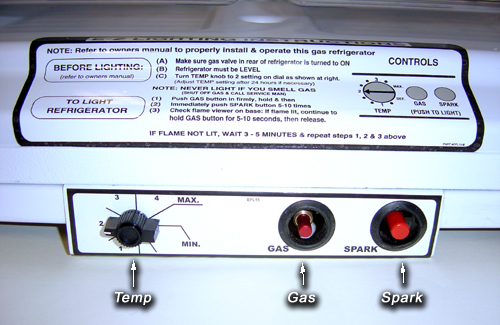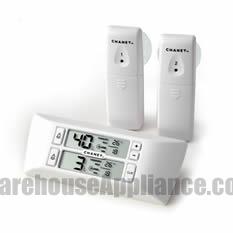How to adjust the temperature
Over the years we have sold thousands of propane refrigerators and almost all of them have ended up in a remote location for use in a home or cabin that does not have electricity. Off-Grid owners seem to be more interested in adjusting their gas refrigerators to the proper temperatures than compared to owners of common electric refrigerators. The reasons for this can be;
Propane is usually trucked to the location or hand carried so it is safe to say that conserving of the gas usage is valued.
Most rural off grid homes, cabins, and cottages don’t have automatic climate control. This means the off grid refrigerator is subject to a wider range of ambient temperatures during the day as well as the seasonal changes.
Gas refrigerators are all manual temperature controlled. No digital thermostats or electronics whatsoever. This is what you would expect from a non-electric refrigerator.
For those seeking an education on setting the temperature, I’m going to split it up into two parts. Part Time Living and Full Time Living.
 Part Time Living with a Propane Gas Refrigerator –
Part Time Living with a Propane Gas Refrigerator –
Since a fair number of our customers use the fridges at a weekend getaway or during a short vacation, they will typically turn the unit on upon arrival and shut it down when they leave. The largest propane refrigerator in the world made by EZ Freeze measures out to be 21 cubic feet. Chill down time for one of these units if it is empty will be 10 to 12 hours in 70 to 80 degree ambient air temperature. There are a few do’s and don’ts during this chill down time that is critical to operation during the next few days.
- Do keep the door closed as much as possible.
- Don’t load the fridge with any food or liquids that are not cold or frozen.
- Do set the temperature setting to Maximum.
These are all common sense but you would be surprised at how many people overlook these rules. Especially rule #1. Guests and children that don’t understand absorption refrigeration will open the door to look inside by habit. It’s important to educate them.
After the chill down time is over, it is good practice to load the food goods in smaller amounts at timed intervals. Rule of thumb for ambient temperature food is 10 pounds every 2 hours. Loading frozen goods or cold foods will not have any adverse effects, so it’s OK to load your entire cache at this time. As for the ambient temp foods, if you load a high volume at one time, it is likely that the fridge will take 3 times longer to recover to safe food keeping temperatures than if you load only 10 pounds at a time over a longer period. Loading large amounts of ambient temperature liquids is also bad practice. Liquid is the most dense food and will take the most energy to cool. One way to cheat the process is to use smaller containers of liquids therefore increasing the air contact surface area. This helps greatly to get the drinks cold. 4 Quarts of water will chill or freeze faster than 1 gallon.
My advice to weekenders is to keep the thermostat set to maximum and replenish the ice trays or drinks at night right before bedtime. In some cases where a large party of guests are on hand, we suggest to not use the fridge for drinks. Using the fridge for drinks puts a huge strain on any type of fridge, gas (absorption) or electric (compressor). Using an ice chest for drinks keeps the fridge door closed more often and cuts down on the kitchen traffic too. Chefs love this idea.
Full Time Living with a Propane Gas Refrigerator –
For our “Full Timer” customers, your initial startup up rules are basically the same as the “Part Timer” rules. And you can also use these rules when you bring groceries home from the weekly shopping trip. 10 pounds every 2 hours still applies here. Beyond that, it is important to stabilize your temperature and thermostat setting. The most important area to monitor is the refrigerator interior temperatures. Due to the nature of how a gas refrigerator works, the thermostat setting will primarily affect the refrigerator compartment temperatures. There is no thermostat for the freezer. All the temperature setting is done by one thermostat located at the very bottom of the cabinet on the outside front near or behind the kick plate. This is true for all brands of gas powered home type refrigerators made by EZ Freeze, Diamond, Miller Refrigeration, Crystal Cold, Dometic, Sevel, Consul, Danby, and Unique. The control panel will be labeled with numbers that do not correspond with temperature. The numbers are simply a reference.

Stabilizing the temperature is fairly simple. It just takes a little time. Starting at the maximum setting as described in the initial startup, monitor the temperatures of the fridge compartment taking the “true” reading first thing in the morning before the door is opened. When this reading reaches freezing at 32 degrees, start to slightly move the dial toward the minimum setting by approximately 1/12 of a turn. Do this every morning until the temperature reaches your target. My target is usually 34 to 38 degrees.
Slight adjustments from this point can be made to compensate for seasonal changes and usage variations. We like to prejudge the high usage times and lower the temperatures in advance to get a head start on the recovery times. For instance, if you are planning a party or family get together, turn the thermostat toward maximum the night prior to the event.
Seasonal changes will usually demand an adjustment. Not only for temperature, but humidity levels will affect the settings more dramatically. High humidity will also produce more frost on the cooling fins and can reduce efficiency. Defrosting is another area of maintenance that can help with temperature stabilization.
One last note, a full refrigerator of cold food will be more temperature stable during the day than one with less food. It is due to the mass of food versus the mass of air. The food mass will retain the cold whereas the air mass will fall out when the door is opened.





